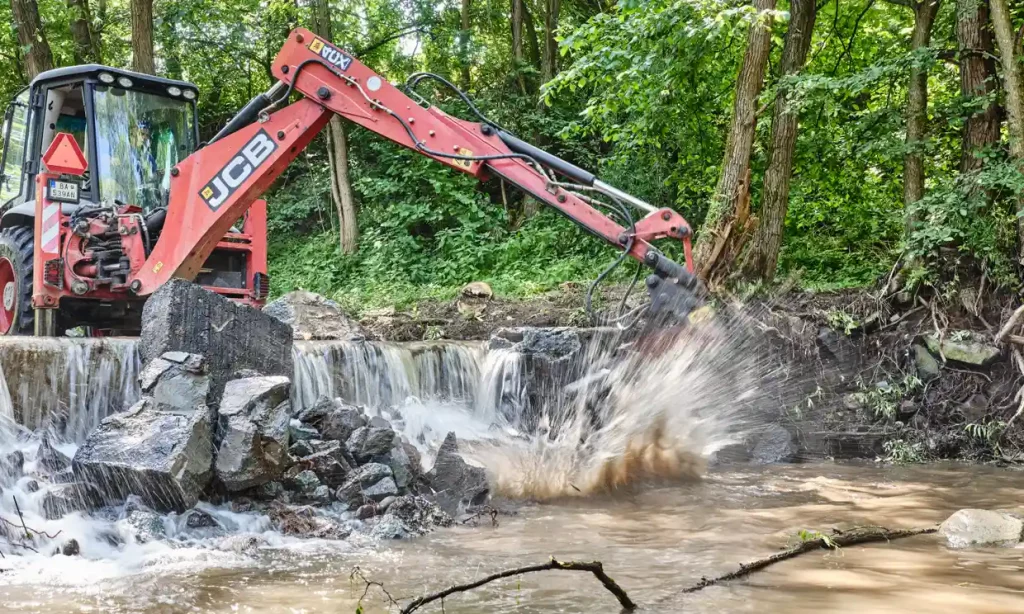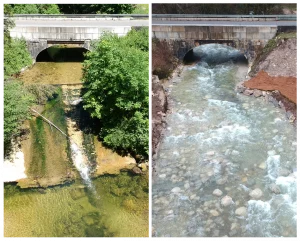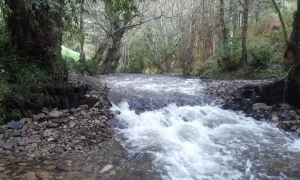by Graeme Green / The Guardian
[All words in brackets added by EF!N editor]

Dam busters: a structure is removed on the Hučava River in Slovakia, June 2021. Photograph: Rob Kleinjans
At least 239 barriers, including dams and weirs, were removed across 17 countries in Europe in 2021, in a record-breaking year for dam removals across the continent.
Spain led the way, with 108 structures taken out of the country’s rivers. “Our efforts to expand dam removals across Europe are gathering speed,” said Pao Fernández Garrido, project manager for the World Fish Migration Foundation, who helped produce Dam Removal Europe’s annual report.
“An increasing number of governments, NGOs, companies and communities are understanding the importance of halting and reversing nature loss, and buying into the fact that dam removal is a river-restoration tool that boosts biodiversity and enhances climate resilience. We’re also seeing lessons being learned from previous dam removals, new countries kickstarting removals, and new funds, including crowdfunding.”
More than 1m barriers are estimated to exist on Europe’s rivers, with many built more than a century ago.
Dams, weirs and other river obstacles block fish migration routes, often leading to the loss of breeding areas and reduced numbers of species such as salmon, sturgeon, trout and eel, which affects the wider biodiversity of ecosystems, including species ranging from eagles to otters. Free-flowing rivers also transport sediments and nutrients.

Before-and-after shots of a dam removal on a river in Parc naturel régional du Haut-Jura, France, in 2021
“Removing dams is a real need,” said Fernández Garrido. “We have hundreds of thousands of abandoned barriers, which is a safety problem. Dams affect water quality and underground water levels, cause channel and coastal erosion and beach disappearances, generate greenhouse gas emissions and lead to declines and even extinctions of migratory fish populations, with a 93% decline of migratory fish in Europe in the last 50 years. Dams have a negative impact on the environment, so if a dam or weir isn’t strictly necessary any more, [and, none of them are] we mustn’t pass the burden to future generations.”
Dam Removal Europe is a coalition of seven organisations, including the World Fish Migration Foundation, WWF, the Rivers Trust and Rewilding Europe, working to restore healthy, free-flowing rivers across the continent. The latest report found that 76% of the removals were of small dams and weirs, but 24% were higher than 2 metres. Three countries – Portugal, Montenegro, and Slovakia – recorded their first ever dam removals in 2021. In Finland, a functioning hydropower dam was also dismantled, the first of three on the Hiitolanjoki River, which, when completed, is expected to allow landlocked salmon to return to spawning grounds.
“This is the perfect example to show that when an operating hydropower dam isn’t needed, [as it never is] and energy can be supplied by other sources [as it always can], it’s worth removing it and recovering the river,” said Fernández Garrido. “The river will be totally free of dams for the first time in over 120 years.”
Spain removed 108 barriers from its rivers in 2021, including the 13m-high Anllarinos dam, the tallest European dam taken out last year. “Spanish law is one of the best [laws] for dealing with dams,” said Rafael Seiz from WWF-Spain’s Freshwater Programme. “Spain has legislation that obligates the owner to pay for its infrastructure removal once they stop using it.”

The Cantabrian River Basin Authority in Spain removed 50 barriers in 2021. Photograph: CRBA
“Spain, France, Denmark, Finland and the UK are blazing a trail,” said Fernández Garrido. “There are other countries that need to make strong efforts to start, such as Italy, Portugal and Greece, and almost all countries in eastern Europe, where many proponents of dam removals are still afraid to openly talk about it.”
With dramatic declines in freshwater fish populations, restoring free-flowing rivers is seen as urgent. “We truly think 2022 will beat 2021, [because] financial aids are being created to help cover the removal costs, like the new Open Rivers Programme, which will invest €42.5m over the next six years to help remove river barriers in Europe,” said Fernández Garrido.
“We really want to see governments from all countries taking action and creating national grants and plans to completely free some of their rivers from obstacles, so there is, at least, a free and healthy river per country. We’re talking about creating a big shift.”
